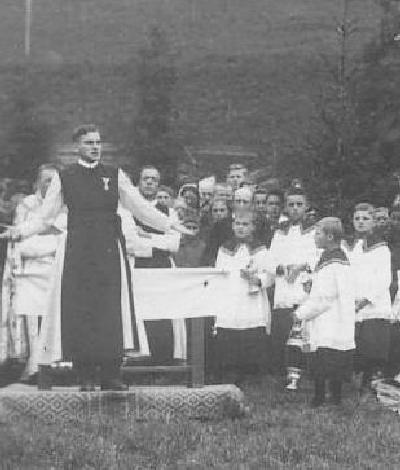
Boys' Religious Costume: Austrian Altar Boys

Figure 1.--This was a religious service being held outdoors. It was taken for " Fahnenweihe des Kameradeschaftsvereines ehermaliger Krieger ". This would translate as something like, "flag blessing ceremony (or flag benediction ceremony) of the companionship union of former warriors." It is not clear to be just what banner or flag the priest is blessing. The priest was a former soldier. This was not a mass but a ceremony. Two of these altar boys sang several chants. One altar boy is holding a censer, which is a vessel for burning incense. As you may be able to see in the photo, the censer is suspended by chains, and perhaps you've seen church services where incense is used, and will remember that the smoke emanates from a censer swung by either a priest or an altar boy.
We are not sure what the other altar boy is holding. Nor do we know when this photograph was taken, probably about 1950.
|
A French reader tells us that he served as an altar boy in both Austria and France. The experience and the costume he wore was very similar in both countries. While the basic asltar boy costume was set by the Vatican and was the same in different countries, we have noted some Austrian altar boys wearing destinctive costumes. Some looked rather like page boy costumes. I am not sure how common these outfits were. They may been primarily used in a variety of folk events. A HBC reader also mentions the altar boys that wear page uniforms because of the Leonardiritt in Pettenbach. The age is usually set on 14 years, but can be also one or 2 years later.
Chronology
We have little chronological information at this time. Er note the boys in the image here no longer wear red scullcaps. We do not some changes over time. Note the large collar-like garments that these boys are wearing. The origin of this collar was a cape. It became shorter and shorter over time. Today this garment no longer is worn.
Vestments
A French reader tells us that the French and Austrian altar boy vestments were basically the same. Some little variations can be found in the lenght of the surplis or of the " chassube ". I should mention, in the Austrian image seen here (figure 1) as el as in some French images, one can see altar boys with a sort of large collar. It is not a collar but a " Schultertuch " " Cape "in German. It is also called a "Cape" in French. This garment can be very simple or made with elabirate emboidery. There is a little cord at the neck.
Outdoor Ceremonies
Here we see a religious service being held outdoors. It was taken for " Fahnenweihe des Kameradeschaftsvereines ehermaliger Krieger ".
I think this is a ceremony to remember comrads lost in World War II.
The priest was a former soldier. This was not a mass but a ceremony.
For outdoor ceremonies, if the priest has the " Ostensoir " ( a cross with in the middle a consecrated host ) or in case of using the encensoir then the priest wore a " Pluvial " and the altar boys the large collars seen here (figure 1).
HBC

Navigate the Boys' Historical Clothing Austrian pages:
[Main Austrian religious page]
[Austrian choirs]
[Austrian school uniforms]
[Lederhosen]
Navigate the Boys' Historical Clothing Web Site:
[Introduction]
[Activities]
[Biographies]
[Chronology]
[Clothing styles]
[Countries]
[Bibliographies]
[Contributions]
[Essays]
[FAQs]
[Glossaries]
[Satellites]
[Tools]
[Boys' Clothing Home]
Navigate the Boys' Historical Clothing national pages:
[Return to the Main Austraian page]
[Australia]
[Belgium]
[England]
[France]
[Germany]
[Ireland]
[Italy]
[Japan]
[Korea]
[Mexico]
[New Zealand]
[Scotland]
[United States]
Created: February 18, 2003
Last updated: 12:47 AM 4/17/2005



